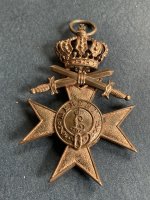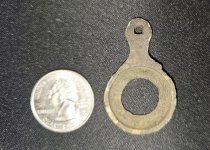Michigan Badger
Gold Member
A while back I purchased a new machine which I purposely won't name in this post (I buy lots of machines). I'll only say it is in the $500 range. I took it to my coin garden and found that it can only detect a silver quarter at 7 inches max IN MY SOIL. I also own a cheapo detector I bought off ebay for $60 (new) and it gets 10+ inches on a silver quarter.
Now, out yonder in the real world one would think the SUPER deeper machine would be the winner, right? WRONG! I've used this cheapo for maybe 500 hours over the last 4 years and found few pre-1900's coins with it. However, I did find loads of larger relics but little silver and no gold (no rings).
Now back to my latest machine. In less than 30 hours hunting/learning time I've found about 15 early wheat cents, 3 old rings, 1 silver dime, 1865 Indian head penny, large silver medal, loads of clad, an engraved pocket knife, a brass rein guide for an old buggy, and too many things to mention all from the same sites I hunted many times with the deep machine (and other top brands known for exterme depth).
So what's the deal? The cheapo is much deeper in the test garden but when it comes to actual work in the field it fails to deliver.
Extreme depth is NOT the winner for MOST (not all) coin shooting in THE UNITED STATES.
Most of us work for a living and have only a few hours now and then to do metal detecting. So, we're hunting mainly yards, parks, ball fields, sidewalks, and vacant lots.
I can use my cheapo detector all day in these areas and find little or nothing. Why? Because it can't separate the trash from the treasure very well, that's why. Find a coin all by itself and it's toast with the deep machine. But, how often does that happen?
Today a major amount of the price we pay for our expensive machines goes to make them excellent target separators. Depth is a given, that is, it's more than good enough in most VLF models (not all) offered today from $50 to $1,200. So why the big price difference? It?s all about technology in discerning or distinguishing targets. Or in other words, target separation.
Now, assuming ones detector has reasonable depth, hunting parks and yards today is all about target separation. The goodies still out there are mixed in with all kinds of trash and many very old coins are on edge.
Here's a real educator: Learn to pinpoint perfectly and use a plug digger for coins. When you detect a coin, plug it and then carefully check the depth. You'll be shocked at how shallow that find really was. Most detector meters register 30 to 50% deeper than the find really is. If a meter shows 7 inches it's most likely 3 to 5 inches deep.
Think target separation.
Now, out yonder in the real world one would think the SUPER deeper machine would be the winner, right? WRONG! I've used this cheapo for maybe 500 hours over the last 4 years and found few pre-1900's coins with it. However, I did find loads of larger relics but little silver and no gold (no rings).
Now back to my latest machine. In less than 30 hours hunting/learning time I've found about 15 early wheat cents, 3 old rings, 1 silver dime, 1865 Indian head penny, large silver medal, loads of clad, an engraved pocket knife, a brass rein guide for an old buggy, and too many things to mention all from the same sites I hunted many times with the deep machine (and other top brands known for exterme depth).
So what's the deal? The cheapo is much deeper in the test garden but when it comes to actual work in the field it fails to deliver.
Extreme depth is NOT the winner for MOST (not all) coin shooting in THE UNITED STATES.
Most of us work for a living and have only a few hours now and then to do metal detecting. So, we're hunting mainly yards, parks, ball fields, sidewalks, and vacant lots.
I can use my cheapo detector all day in these areas and find little or nothing. Why? Because it can't separate the trash from the treasure very well, that's why. Find a coin all by itself and it's toast with the deep machine. But, how often does that happen?
Today a major amount of the price we pay for our expensive machines goes to make them excellent target separators. Depth is a given, that is, it's more than good enough in most VLF models (not all) offered today from $50 to $1,200. So why the big price difference? It?s all about technology in discerning or distinguishing targets. Or in other words, target separation.
Now, assuming ones detector has reasonable depth, hunting parks and yards today is all about target separation. The goodies still out there are mixed in with all kinds of trash and many very old coins are on edge.
Here's a real educator: Learn to pinpoint perfectly and use a plug digger for coins. When you detect a coin, plug it and then carefully check the depth. You'll be shocked at how shallow that find really was. Most detector meters register 30 to 50% deeper than the find really is. If a meter shows 7 inches it's most likely 3 to 5 inches deep.
Think target separation.
Amazon Forum Fav 👍
Upvote
0




 Hey, we all want our brands to be the best, right?
Hey, we all want our brands to be the best, right?

